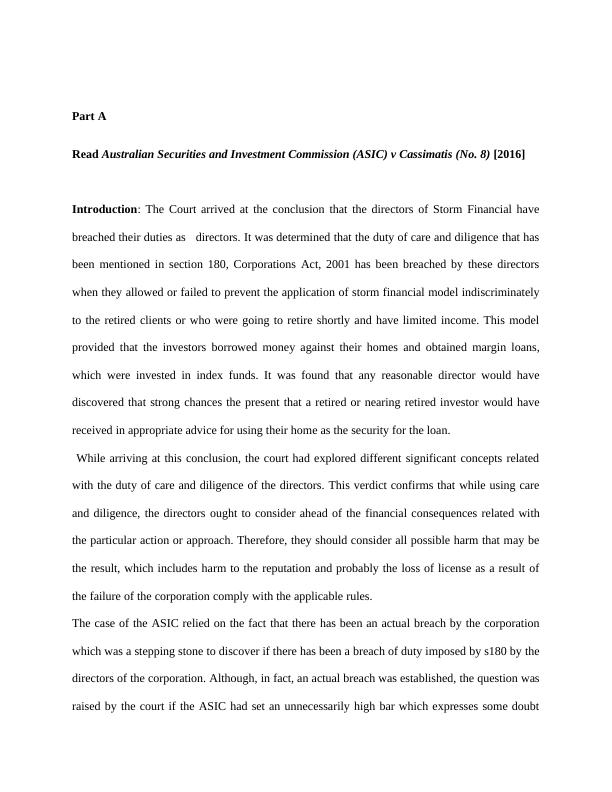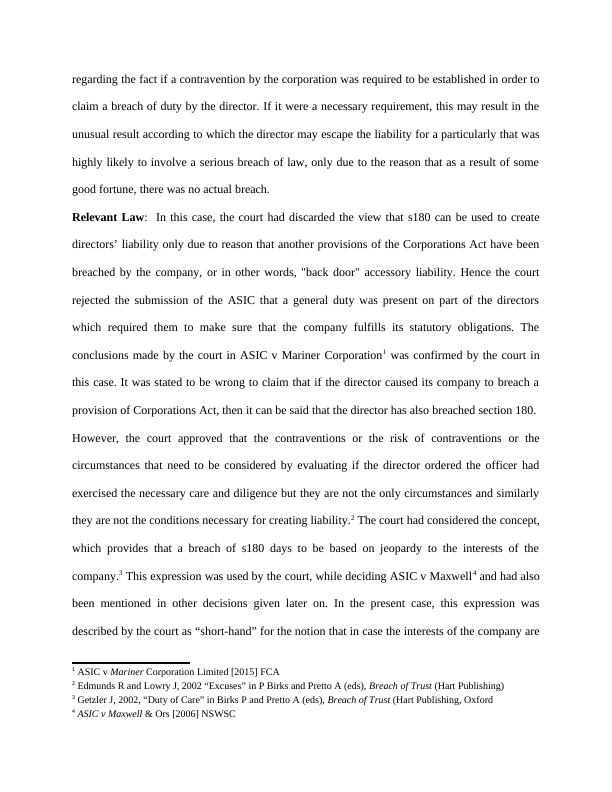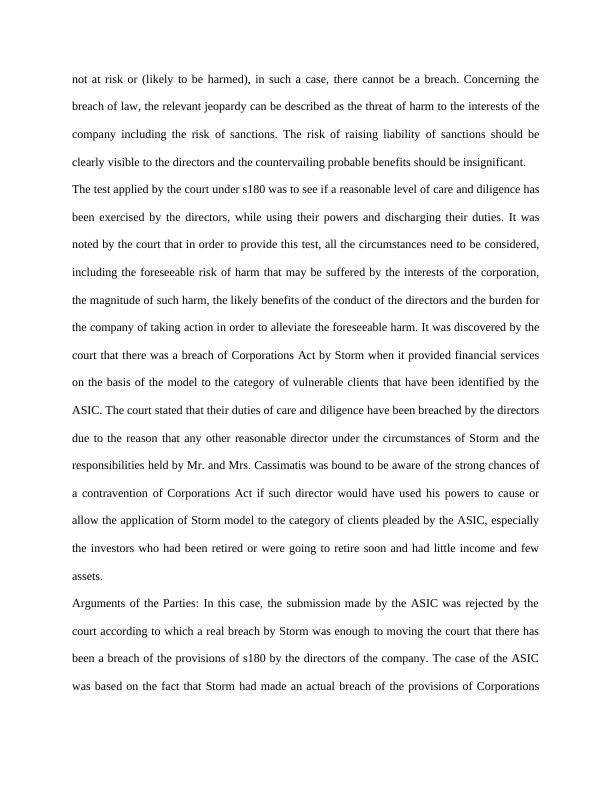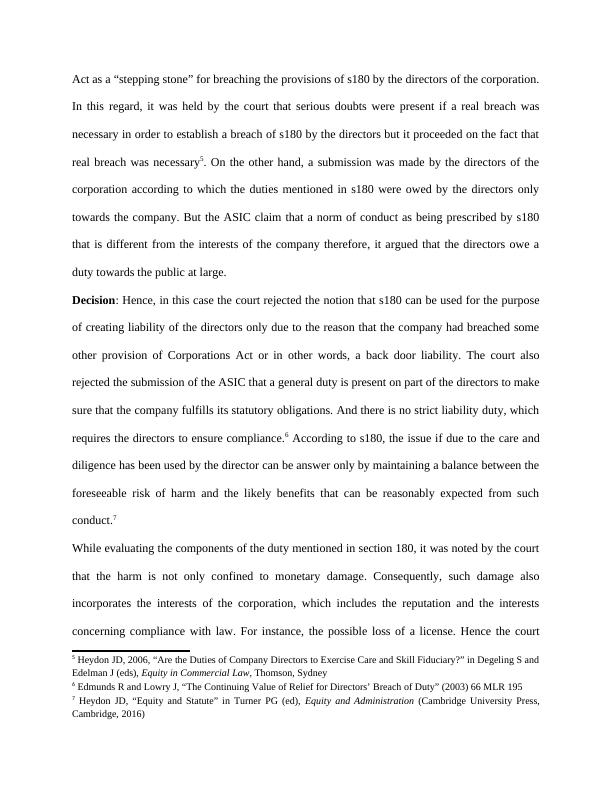Australian Securities and Investment Commission (ASIC) v Cassimatis
12 Pages3669 Words75 Views
Added on 2020-02-19
Australian Securities and Investment Commission (ASIC) v Cassimatis
Added on 2020-02-19
ShareRelated Documents
Part ARead Australian Securities and Investment Commission (ASIC) v Cassimatis (No. 8) [2016]Introduction: The Court arrived at the conclusion that the directors of Storm Financial havebreached their duties as directors. It was determined that the duty of care and diligence that hasbeen mentioned in section 180, Corporations Act, 2001 has been breached by these directorswhen they allowed or failed to prevent the application of storm financial model indiscriminatelyto the retired clients or who were going to retire shortly and have limited income. This modelprovided that the investors borrowed money against their homes and obtained margin loans,which were invested in index funds. It was found that any reasonable director would havediscovered that strong chances the present that a retired or nearing retired investor would havereceived in appropriate advice for using their home as the security for the loan. While arriving at this conclusion, the court had explored different significant concepts relatedwith the duty of care and diligence of the directors. This verdict confirms that while using careand diligence, the directors ought to consider ahead of the financial consequences related withthe particular action or approach. Therefore, they should consider all possible harm that may bethe result, which includes harm to the reputation and probably the loss of license as a result ofthe failure of the corporation comply with the applicable rules.The case of the ASIC relied on the fact that there has been an actual breach by the corporationwhich was a stepping stone to discover if there has been a breach of duty imposed by s180 by thedirectors of the corporation. Although, in fact, an actual breach was established, the question wasraised by the court if the ASIC had set an unnecessarily high bar which expresses some doubt

regarding the fact if a contravention by the corporation was required to be established in order toclaim a breach of duty by the director. If it were a necessary requirement, this may result in theunusual result according to which the director may escape the liability for a particularly that washighly likely to involve a serious breach of law, only due to the reason that as a result of somegood fortune, there was no actual breach.Relevant Law: In this case, the court had discarded the view that s180 can be used to createdirectors’ liability only due to reason that another provisions of the Corporations Act have beenbreached by the company, or in other words, "back door" accessory liability. Hence the courtrejected the submission of the ASIC that a general duty was present on part of the directorswhich required them to make sure that the company fulfills its statutory obligations. Theconclusions made by the court in ASIC v Mariner Corporation1 was confirmed by the court inthis case. It was stated to be wrong to claim that if the director caused its company to breach aprovision of Corporations Act, then it can be said that the director has also breached section 180.However, the court approved that the contraventions or the risk of contraventions or thecircumstances that need to be considered by evaluating if the director ordered the officer hadexercised the necessary care and diligence but they are not the only circumstances and similarlythey are not the conditions necessary for creating liability.2 The court had considered the concept,which provides that a breach of s180 days to be based on jeopardy to the interests of thecompany.3 This expression was used by the court, while deciding ASIC v Maxwell4 and had alsobeen mentioned in other decisions given later on. In the present case, this expression wasdescribed by the court as “short-hand” for the notion that in case the interests of the company are1 ASIC v Mariner Corporation Limited [2015] FCA2 Edmunds R and Lowry J, 2002 “Excuses” in P Birks and Pretto A (eds), Breach of Trust (Hart Publishing)3 Getzler J, 2002, “Duty of Care” in Birks P and Pretto A (eds), Breach of Trust (Hart Publishing, Oxford4ASIC v Maxwell & Ors [2006] NSWSC

not at risk or (likely to be harmed), in such a case, there cannot be a breach. Concerning thebreach of law, the relevant jeopardy can be described as the threat of harm to the interests of thecompany including the risk of sanctions. The risk of raising liability of sanctions should beclearly visible to the directors and the countervailing probable benefits should be insignificant.The test applied by the court under s180 was to see if a reasonable level of care and diligence hasbeen exercised by the directors, while using their powers and discharging their duties. It wasnoted by the court that in order to provide this test, all the circumstances need to be considered,including the foreseeable risk of harm that may be suffered by the interests of the corporation,the magnitude of such harm, the likely benefits of the conduct of the directors and the burden forthe company of taking action in order to alleviate the foreseeable harm. It was discovered by thecourt that there was a breach of Corporations Act by Storm when it provided financial serviceson the basis of the model to the category of vulnerable clients that have been identified by theASIC. The court stated that their duties of care and diligence have been breached by the directorsdue to the reason that any other reasonable director under the circumstances of Storm and theresponsibilities held by Mr. and Mrs. Cassimatis was bound to be aware of the strong chances ofa contravention of Corporations Act if such director would have used his powers to cause orallow the application of Storm model to the category of clients pleaded by the ASIC, especiallythe investors who had been retired or were going to retire soon and had little income and fewassets. Arguments of the Parties: In this case, the submission made by the ASIC was rejected by thecourt according to which a real breach by Storm was enough to moving the court that there hasbeen a breach of the provisions of s180 by the directors of the company. The case of the ASICwas based on the fact that Storm had made an actual breach of the provisions of Corporations

Act as a “stepping stone” for breaching the provisions of s180 by the directors of the corporation.In this regard, it was held by the court that serious doubts were present if a real breach wasnecessary in order to establish a breach of s180 by the directors but it proceeded on the fact thatreal breach was necessary5. On the other hand, a submission was made by the directors of thecorporation according to which the duties mentioned in s180 were owed by the directors onlytowards the company. But the ASIC claim that a norm of conduct as being prescribed by s180that is different from the interests of the company therefore, it argued that the directors owe aduty towards the public at large.Decision: Hence, in this case the court rejected the notion that s180 can be used for the purposeof creating liability of the directors only due to the reason that the company had breached someother provision of Corporations Act or in other words, a back door liability. The court alsorejected the submission of the ASIC that a general duty is present on part of the directors to makesure that the company fulfills its statutory obligations. And there is no strict liability duty, whichrequires the directors to ensure compliance.6 According to s180, the issue if due to the care anddiligence has been used by the director can be answer only by maintaining a balance between theforeseeable risk of harm and the likely benefits that can be reasonably expected from suchconduct.7While evaluating the components of the duty mentioned in section 180, it was noted by the courtthat the harm is not only confined to monetary damage. Consequently, such damage alsoincorporates the interests of the corporation, which includes the reputation and the interestsconcerning compliance with law. For instance, the possible loss of a license. Hence the court5 Heydon JD, 2006, “Are the Duties of Company Directors to Exercise Care and Skill Fiduciary?” in Degeling S andEdelman J (eds), Equity in Commercial Law, Thomson, Sydney6 Edmunds R and Lowry J, “The Continuing Value of Relief for Directors’ Breach of Duty” (2003) 66 MLR 1957 Heydon JD, “Equity and Statute” in Turner PG (ed), Equity and Administration (Cambridge University Press,Cambridge, 2016)

End of preview
Want to access all the pages? Upload your documents or become a member.
Related Documents
LAWS19032 Company & Association Law - CQUlg...
|13
|3441
|66
Storm Financial Limited Assignment Reportlg...
|8
|1744
|24
Breach of Directors Duties under Corporation Act 2001 - ASIC v Cassimatis (No. 8) [2016] FCA 1023lg...
|12
|657
|91
Business Laws and Corporation ACT | Assignmentlg...
|9
|2220
|199
LAWS4005 - Company Law- Australian Securities and Investment Commissionlg...
|15
|3670
|40
Shafron v ASIC Case Studylg...
|4
|685
|130
